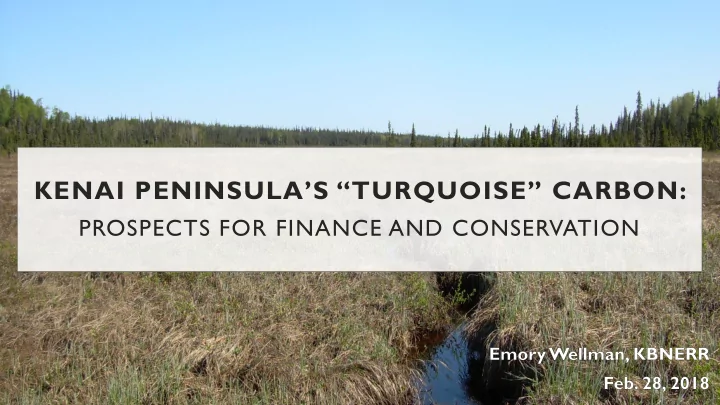

KENAI PENINSULA’S “TURQUOISE” CARBON: PROSPECTS FOR FINANCE AND CONSERVATION
PEAT AND PEATLANDS What is peat? • Partially-decomposed plant material • Oxygen-poor, waterlogged environments • “Sponge-like” PEATMAN, http://peatman.eu/
PEAT AND PEATLANDS What is peat? • Partially-decomposed plant material • Oxygen-poor, waterlogged environments • “Sponge-like” capacity What is a peatland? • An area covered with accumulated peat, with or without other vegetation
PEATLAND FUNCTIONS AND VALUES REGULATION PRODUCTION COMMUNITY/CULTURE • Water storage and • Extraction • Recreation transmission (inc. floodwater) • Provision of plants and animals • Education • Groundwater recharge (subsistence) • Culture/heritage (subsistence) • Water quality • Carbon storage and sequestration
CARBON STORAGE & SEQUESTRATION • Rapid vegetation growth • Reduced decomposition: • Holds water (15 – 20 times dry weight) • Acidifies surroundings • Lignin-like compounds • Boreal/subarctic peatlands: 455 Pg C • About ⅓ of total world soil carbon • Alaskan peatlands: 71.5 Pg C
PEATLANDS ON THE PENINSULA • Most common wetland type on the lower Peninsula • Most peatlands are fens • Bogs are rare Map by Jacob Argueta (KBRR)
SITUATION REPORT • Majority of Peninsula wetlands are in “reference” condition • Relatively undisturbed by human activity, natural, self-sustaining functions more or less unimpaired • Management Implications • Stressors • Extraction • Development • Housing, roads, agriculture • Climate impacts?
“Czech investments for expanding peat extraction in Brest Oblast”, http://investinbelarus.by
SITUATION REPORT • Vast majority of Peninsula wetlands are in “reference” condition • Relatively undisturbed by human activity, natural, self-sustaining functions more or less unimpaired • Management Implications • Stressors • Extraction • Development • Housing, roads, agriculture • Climate impacts?
Roads on Peat, ROADEX, www.roadex.org
SITUATION REPORT • Vast majority of Peninsula wetlands are in “reference” condition • Relatively undisturbed by human activity, natural, self-sustaining functions more or less unimpaired • Management Implications • Stressors • Extraction • Development • Housing, roads, agriculture • Climate impacts?
“New Research Outlines Global Threat of Smoldering Peat Fires”, http://wildfiretoday.com/tag/peat/
CARBON FINANCE AND CONSERVATION Cap and Trade • Cap : A limit on greenhouse gas emissions, which is split into “allowances”, giving companies the right to emit that amount • Trade : Market where companies can buy and sell allowances if they over- or under-emit Offset : An emissions reduction made to compensate for – to offset – emissions made elsewhere. Graphic by Mike Forbush, https://425business.com/cap-trade-innovation-burden/
THE VOLUNTARY CARBON MARKET • Standards created by the industry • Use: Corporate responsibility, imaging, and speculation • Smaller market, cheaper credits • Lower development and transaction costs • More flexible, less onerous Center for Alaskan Coastal Studies, https://www.akcoastalstudies.org
HOW IS THIS RELEVANT TO THE KENAI PENINSULA? This work has been funded through the National Estuarine Research Reserve Science Collaborative, administered by the University of Michigan. KBBI, http://kbbi.org/
VCS VM0007: REDD+MF • “Project activities that reduce emissions from planned (APWD) and unplanned (AUWD) wetland degradation” • APWD: “conversion of wetlands to a degraded condition must be legally permitted” • Allows for restoration or “conservation of intact wetlands” (CIW) • Sets out requirements for designing, completing, and monitoring a project VCS, VM0007 Methodology Revised to Include REDD+ Activities on Peatlands
WHERE DO WE GO FROM HERE? Summer field trips with KBNERR • Join experts from the Smithsonian and WBNERR in studying carbon storage and marketing • Stay tuned!
WHERE DO WE GO FROM HERE? Summer field trips with KBNERR • Join experts from the Smithsonian and WBNERR in studying carbon storage and marketing • Stay tuned! Modeling • Estimate carbon storage • Potential model inputs Natural Capital Project, http://data.naturalcapitalproject.org/
FOREST CARBON WORKS STEPS 1. Create account, apply, determine eligibility 2. Use provided smart phone and app to photograph trees, measuring forest carbon 3. Submit collected information and receive membership offer, outlining expected payments 4. If membership offer is accepted, receive annual payments “About Us”, https://www.forestcarbonworks.org/about-us/
LEARN MORE! • Cook Inlet Wetlands • www.cookinletwetlands.info • Homer Soil and Water Conservation District • Kenai Peninsula Wetlands: A Guide for Everyone • Managing Kenai Peninsula Wetlands • Peninsula Flex and Parcel Viewers • http://mapserver.borough.kenai.ak.us/flexviewer/ • http://maps.kpb.us/kpbmapviewer/ • Web Soil Survey (Natural Resources Conservation Service)
QUESTIONS?
REFERENCES International Peatland Society, “Functions of peatlands.” http://www.peatsociety.org/peatlands-and-peat/functions-peatlands Homer Soil and Water Conservation District (2013), Kenai Peninsula Wetlands: A Guide For Everyone . ecoPartners, Forest Carbon Works , https://www.forestcarbonworks.org/ Rabinowtiz, Jesse (2017) “Kachemak Bay wetlands could be profitable for landowners,” KBBI. http://kbbi.org/post/kachemak-bay-wetlands-could-be- profitable-landowners Natural Capital Project, InVEST. https://www.naturalcapitalproject.org/invest/ Halsey, Linda A., et al. “Sphagnum-Dominated Peatlands in North America Since the Last Glacial Maximum: Their Occurrence and Extent.” The Bryologist , vol. 103, no. 2, 2000, pp. 334–352. Gorham, Eville. “Northern Peatlands: Role in the Carbon Cycle and Probable Responses to Climatic Warming.” Ecological Applications , vol. 1, no. 2, 1991, pp. 182–195. Loisel, Julie, and ZichengYu. “Recent Acceleration of Carbon Accumulation in a Boreal Peatland, South Central Alaska.” Journal of Geophysical Research: Biogeosciences , vol. 118, no. 1, 2013, pp. 41–53. Cleary, Julian, et al. “Greenhouse Gas Emissions from Canadian Peat Extraction, 1990-2000: A Life-Cycle Analysis.” AMBIO: A Journal of the Human Environment , vol. 34, no. 6, 2005, p. 456-461. FAO, “Peatlands and Organic Soils.” http://www.fao.org/in-action/micca/knowledge/peatlands-and-organic-soils/en/. Kenai Peninsula Borough, KPB Flex Parcel Viewer. http://mapserver.borough.kenai.ak.us/flexviewer/
PHOTO CREDITS • PEATMAN, http://peatman.eu/ • “Czech investments for expanding peat extraction in Brest Oblast”, http://investinbelarus.by • Roads on Peat, ROADEX, www.roadex.org • “New Research Outlines Global Threat of Smoldering Peat Fires”, http://wildfiretoday.com/tag/peat/ • Mike Forbush, https://425business.com/cap-trade-innovation-burden/ • Center for Alaskan Coastal Studies, https://www.akcoastalstudies.org • KBBI, http://kbbi.org/ • VCS, VM0007 Methodology Revised to Include REDD+ Activities on Peatlands • Natural Capital Project, http://data.naturalcapitalproject.org/ • “About Us”, https://www.forestcarbonworks.org/about-us/
Recommend
More recommend